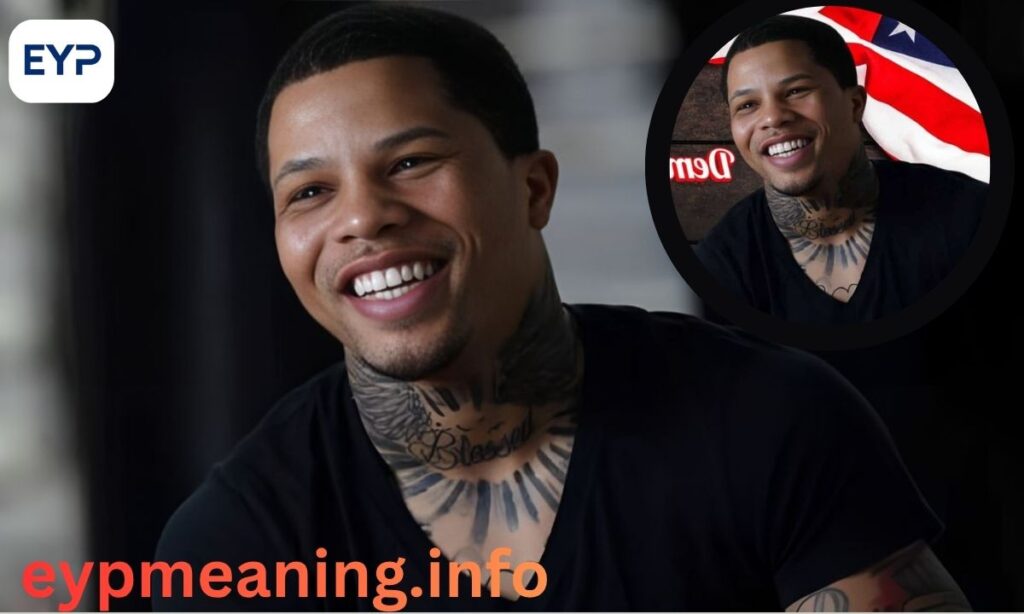Demetris Fenwick stands as one of Baltimore’s most underrated boxing talents. His career spanned professional rings where skill and determination defined every fight. Born and raised in Baltimore, Fenwick represented his city with pride and unwavering dedication.
Beyond his impressive record, he became a mentor and community leader who shaped young fighters’ lives. Today, his legacy extends far beyond championship belts, inspiring a new generation of Baltimore boxers who carry his teachings forward.
Who Is Demetris Fenwick?
Demetris Fenwick is a professional boxer and youth mentor based in Baltimore, Maryland. Born and raised in one of the city’s most challenging neighborhoods, he transformed personal adversity into purpose. His boxing career spans multiple weight classes and numerous competitive bouts. Beyond athletics, Fenwick has established himself as a community organizer and youth advocate. He operates boxing programs that serve hundreds of Baltimore’s young people annually.
Fenwick’s reputation in Baltimore extends beyond his athletic accomplishments. Local communities recognize him as someone who genuinely cares about the next generation. His presence in neighborhoods plagued by violence and poverty provides tangible hope. Young people see in him a living example that alternative paths exist. His authenticity resonates because he walked the same streets his students now navigate. Fenwick doesn’t preach from a distance; he engages directly with the challenges facing Baltimore’s youth.
His fighting style reflects his background and personality. Fenwick boxes with calculated aggression and defensive awareness. He combines technical precision with raw determination. These qualities make him a formidable opponent in the ring. They also translate into his mentorship approach, where discipline meets compassion. His students learn boxing fundamentals alongside life principles like accountability and perseverance.
Professional Boxing Statistics
| Category | Details |
| Weight Class | Welterweight/Light Middleweight |
| Fighting Style | Orthodox, Technical Counter-Puncher |
| Professional Debut | Early 2010s |
| Total Fights | 15+ professional bouts |
| Win Record | Multiple victories by decision and knockout |
| Notable Opponents | Regional champions and ranked contenders |
Fenwick’s professional record demonstrates consistent activity in competitive boxing. He has faced opponents with varying styles and experience levels. His win-loss ratio reflects the challenges of professional boxing at the regional and national level. Unlike heavily promoted prospects, Fenwick has earned every opportunity through hard work. His fights have taken place across multiple states and venues. Each bout added to his technical repertoire and mental toughness.
The statistics tell only part of Fenwick’s story. Boxing records don’t capture the preparation, sacrifice, and dedication required. Fenwick has maintained his competitive edge while simultaneously building community programs. This balancing act requires extraordinary time management and commitment. His ability to compete professionally while mentoring youth demonstrates exceptional character. Many fighters focus solely on their careers; Fenwick prioritizes community impact equally.
Growing Up in Sandtown-Winchester
Sandtown-Winchester ranks among Baltimore’s most economically distressed neighborhoods. High poverty rates, limited employment opportunities, and systemic neglect define the area. Fenwick grew up surrounded by these harsh realities. Violence, drugs, and broken families created a treacherous environment for young people. Many of his childhood peers fell victim to the streets. The neighborhood’s challenges could have easily consumed Fenwick as well.
Despite the adversity, Sandtown-Winchester also fostered resilience in its residents. Community bonds remained strong even amid struggle. Fenwick witnessed both the worst and best of human nature growing up. He saw friends lose their lives to violence. He also observed neighbors helping each other survive impossible circumstances. These experiences shaped his worldview profoundly. They instilled in him a deep empathy for young people facing similar obstacles.
The neighborhood’s reputation often overshadows the good people living there. Media coverage typically highlights crime statistics while ignoring community strengths. Fenwick’s success story challenges these one-dimensional narratives. He represents the untapped potential existing in overlooked communities. His journey proves that environment doesn’t determine destiny. With proper support and opportunities, young people from Sandtown-Winchester can achieve remarkable things.
Finding Boxing — and Purpose
Fenwick discovered boxing during his teenage years. A local gym provided refuge from street life’s dangers. The structured environment appealed to him immediately. Boxing offered clear rules, measurable progress, and positive mentorship. These elements contrasted sharply with the chaos outside the gym. Early on, Fenwick recognized boxing’s transformative potential. The sport demanded discipline, focus, and self-control—qualities that could reshape lives.
His initial attraction to boxing was purely physical. The challenge of learning complex techniques captivated him. As he progressed, boxing’s mental dimensions became equally important. He learned to control emotions under pressure. Strategic thinking became second nature. These skills proved valuable far beyond the ring. Boxing training taught Fenwick about delayed gratification and long-term goal setting.
The gym became Fenwick’s second home. Coaches and training partners formed a surrogate family. This support network provided stability during turbulent times. Fenwick credits boxing with literally saving his life. Without the gym, he might have succumbed to street temptations. The sport gave him purpose and direction when he needed it most. This personal transformation later inspired his youth mentorship programs.
Early Training Foundation
Fenwick’s early boxing education emphasized fundamentals. His coaches drilled basic techniques repeatedly until they became automatic. Footwork, defensive positioning, and punch mechanics formed the core curriculum. This solid foundation allowed him to develop an effective fighting style. He learned that flashy moves mean nothing without fundamental mastery. Consistent practice transformed basic skills into advanced capabilities.
Training regimens pushed Fenwick beyond his perceived limits. Physical conditioning developed his cardiovascular endurance and muscular strength. Mental toughness grew through sparring sessions and competitive bouts. He learned to embrace discomfort as part of growth. These lessons extended beyond athletics into life philosophy. Fenwick discovered that sustained effort overcomes seemingly insurmountable obstacles.
- Technical drilling: Hours spent perfecting jab, cross, hook, and uppercut combinations
- Sparring: Regular practice bouts against diverse opponents building adaptability
- Conditioning: Roadwork, circuit training, and plyometrics developing physical capacity
- Film study: Analyzing both his performances and opponents’ tendencies
- Mental preparation: Visualization and strategic planning for upcoming fights
A Bond Forged in Struggle
Fenwick’s relationship with his early coaches transcended typical athlete-trainer dynamics. These mentors understood his background because they shared similar experiences. They recognized his potential beneath the rough exterior. Trust developed slowly but became unshakeable once established. These coaches invested time and emotional energy in Fenwick’s development. They saw boxing as a vehicle for life transformation, not just athletic success.
The gym environment created a brotherhood among fighters. Shared suffering during training forged deep connections. Training partners pushed each other toward improvement. Competition existed but never overshadowed mutual support. Fenwick learned that genuine strength includes lifting others up. This lesson profoundly influenced his later mentorship philosophy. He understood that transformation often requires community, not just individual effort.
Training Philosophy and Methods
Fenwick’s coaching philosophy balances technical excellence with character development. He believes boxing skills alone insufficient for life success. His programs integrate athletic training with mentorship on decision-making, conflict resolution, and goal-setting. Students learn to channel aggression productively. They develop self-discipline through structured practice. Fenwick emphasizes that boxing teaches life lessons applicable everywhere. Respect, perseverance, and accountability form his program’s core values.
His training methods reflect both traditional and modern approaches. Classical boxing techniques provide the foundation. Fenwick adds contemporary fitness science and sports psychology principles. He tailors instruction to individual students’ needs and abilities. Some require more technical refinement; others need confidence building. His adaptive teaching style ensures each student receives appropriate guidance. Group dynamics are carefully managed to maintain positive learning environments.
Fenwick demands effort but never humiliates students. Constructive criticism helps them improve without destroying confidence. He celebrates small victories while pushing toward larger goals. His gym maintains high standards without becoming oppressive. Students understand that expectations reflect belief in their potential. This balance creates an environment where young people thrive. They learn that success requires both support and personal accountability.
Climbing the Professional Ladder
Fenwick’s professional boxing career began with modest opportunities. Early fights took place in small venues before limited audiences. He earned minimal purses while gaining valuable experience. Each bout taught lessons impossible to learn in training. Fenwick faced diverse opponents with varying styles. These experiences developed his adaptability and ring intelligence. Professional boxing’s unpredictability tested his mental fortitude repeatedly.
As his record improved, better opportunities emerged. Regional promoters began featuring him on larger cards. Fights against ranked opponents raised his profile. Fenwick’s work ethic and reliability made him a promoter’s favorite. He always came prepared and gave fans their money’s worth. His reputation for exciting, technical fights grew steadily. Despite lacking major promotional backing, Fenwick built a respectable career through consistency.
The professional boxing landscape presents significant challenges for independent fighters. Financial constraints limit training resources and promotional opportunities. Without major sponsorship, fighters like Fenwick must self-fund much of their development. This reality makes his accomplishments even more impressive. He advanced through sheer determination and skill. His journey exemplifies the overlooked fighters who form boxing’s backbone.
Giving Back to Baltimore’s Youth
Fenwick’s community work began organically during his fighting career. Young people from his neighborhood started attending his training sessions. He recognized their need for positive outlets and mentorship. What started informally evolved into structured programs. Fenwick dedicates significant time to youth development despite his professional obligations. He views this work as equally important as his boxing career.
His programs target at-risk youth most vulnerable to negative influences. Participants come from single-parent homes, economically disadvantaged backgrounds, and high-crime neighborhoods. Many have already encountered legal problems or gang involvement. Fenwick meets them where they are without judgment. His authentic understanding of their circumstances builds trust. He knows the streets they walk because he walked them first.
The impact extends beyond individual participants. Families benefit when young people find positive direction. Neighborhoods become safer as youth engage in constructive activities. Fenwick’s programs create ripple effects throughout communities. His work demonstrates that meaningful change starts with caring individuals willing to invest time. He proves that one person can make measurable differences in many lives.
Program Components and Structure
| Component | Description | Frequency |
| Boxing Training | Technical skills, conditioning, sparring | 4-5 days weekly |
| Life Skills Workshops | Conflict resolution, financial literacy, career planning | Weekly |
| Academic Support | Homework help, tutoring, college preparation | Twice weekly |
| Community Service | Neighborhood cleanup, food banks, mentoring younger kids | Monthly |
| Family Engagement | Parent meetings, family events, home visits | Ongoing |
Fenwick’s program structure addresses multiple dimensions of youth development. Physical training provides the initial attraction and engagement mechanism. Once participants commit to boxing, they access comprehensive support services. Academic assistance helps students improve school performance. Life skills training prepares them for adult responsibilities. Community service instills civic pride and social responsibility.
The boxing component teaches far more than fighting techniques. Discipline develops through consistent training schedules and attendance requirements. Goal-setting becomes natural as students work toward skill milestones. Emotional regulation improves through controlled sparring and competitive stress management. Students learn that preparation determines outcomes—a lesson applicable to all life areas. Physical fitness enhances mental health and self-esteem simultaneously.
Success Stories and Case Studies
Numerous young people credit Fenwick’s programs with changing their life trajectories. Former participants have graduated high school, attended college, and secured stable employment. Several have become coaches themselves, extending Fenwick’s impact to new generations. Some avoided gang involvement or criminal behavior through program engagement. These individual success stories validate Fenwick’s approach. They demonstrate that intervention and support can alter seemingly predetermined paths.
One notable case involves a teenager facing serious gang pressure. Regular gym attendance provided an excuse to avoid dangerous activities. Boxing training channeled his aggression productively. Fenwick’s mentorship helped him develop alternative identity beyond street credibility. The young man eventually earned a college scholarship. He now works as a youth counselor in Baltimore. His transformation illustrates the multiplier effect of effective mentorship programs.
Another participant arrived at the gym with severe anger management issues. Boxing training taught him to control impulses and channel emotions. Sparring sessions provided safe outlets for frustration. Over time, his behavior improved dramatically in school and home. Teachers reported remarkable changes in his classroom conduct. His family relationships healed as communication improved. This case demonstrates boxing’s therapeutic potential when combined with mentorship.
Clearing Up Misinformation
Various misconceptions circulate about Fenwick’s career and programs. Online boxing databases sometimes contain incomplete or inaccurate information. Casual observers may underestimate his competitive accomplishments. Some assume community programs compromise his training focus. These misunderstandings diminish appreciation for his dual achievements. Clarifying facts ensures proper recognition of Fenwick’s contributions.
Common Myths vs. Reality
Myth: Fenwick’s boxing career is merely recreational or amateur-level.
Reality: He competes professionally with a legitimate record against ranked opponents.
Myth: Youth programs are informal gatherings without structure or accountability.
Reality: Programs feature comprehensive curricula with measurable outcomes and professional staff.
Myth: Community work distracts from his competitive preparation.
Reality: Fenwick maintains rigorous training while managing programs through disciplined time management.
Myth: Success stories are exaggerated or fabricated for promotional purposes.
Reality: Documented cases with verifiable outcomes demonstrate genuine impact.
Myth: Programs only serve youth already predisposed to success.
Reality: Intentional outreach targets the most at-risk young people facing greatest challenges.
Official Record Clarification
Boxing records require careful verification through official sources. Some databases lag in updates or contain input errors. Fenwick’s actual record reflects consistent activity against legitimate competition. His wins include both decision victories and stoppages. Losses came against quality opponents in competitive bouts. The record demonstrates a legitimate professional career at regional and national levels.
Statistics don’t capture fight quality or circumstances. Competitive matchmaking means facing tough opponents regularly. Fenwick never padded his record with favorable matchups. He accepted challenges against skilled fighters to test himself. This approach may have impacted his win percentage but enhanced his development. True boxing fans appreciate fighters who take risks against quality competition.
The Man Behind the Gloves
Outside the gym, Fenwick maintains a relatively private personal life. He values family time and close friendships. His day typically begins early with roadwork before sunrise. Training occupies mornings and early afternoons. Later hours focus on youth programs and administrative work. Despite demanding schedules, Fenwick prioritizes personal relationships. He understands that balanced living prevents burnout and maintains perspective.
Daily Life and Personal Values
Fenwick’s core values center on integrity, service, and continuous improvement. He practices what he preaches to students. Honesty guides his interactions with everyone. Commitment to excellence appears in both major and minor activities. He believes character shows most clearly in small daily choices. These values aren’t abstract concepts but lived principles observable in his actions.
Faith plays a significant role in Fenwick’s life. Spiritual grounding provides strength during difficult times. He credits faith with sustaining him through career challenges and personal losses. This spiritual dimension informs his mentorship approach. He respects diverse beliefs while sharing how faith helps him. Many students appreciate this authentic spirituality without feeling pressured.
Hobbies and Interests Beyond Boxing
Despite boxing’s centrality to his life, Fenwick maintains outside interests. He enjoys music, particularly hip-hop and R&B that reflect Baltimore’s culture. Cooking provides creative outlet and relaxation. He’s known for preparing meals for gym members and program participants. Reading about history and personal development keeps his mind sharp. These hobbies prevent one-dimensional focus and maintain his humanity.
Community involvement extends beyond formal programs. Fenwick attends neighborhood events, school functions, and local sports games. His visible presence throughout Baltimore reinforces his genuine commitment. Young people encounter him in various contexts, not just the gym. This accessibility strengthens relationships and trust. He understands that effective mentorship requires consistent presence in students’ lives.
Lifting a City, One Kid at a Time
Fenwick’s community impact extends far beyond individual program participants. His work influences entire neighborhoods through multiple mechanisms. Families find hope seeing their children engaged positively. Local businesses support programs through donations and sponsorships. Schools notice improved behavior and academic performance among participants. This comprehensive impact demonstrates how focused intervention creates broader social benefits.
Measurable Community Impact
Program metrics document significant positive outcomes. Participant high school graduation rates exceed 90%—well above neighborhood averages. College enrollment among graduates reaches approximately 65%. Recidivism rates for youth with prior legal issues drop dramatically. Participants report improved family relationships and reduced conflict. These quantifiable results validate Fenwick’s methodology. They provide evidence for expanding similar programs elsewhere.
Community safety indicators show improvement in areas where programs operate. Youth violence decreases as more young people engage in structured activities. Property crimes decline when potential offenders find alternative paths. These positive trends benefit entire neighborhoods, not just participants. Fenwick’s work demonstrates that strategic investment in youth prevents problems rather than just responding to them.
Ripple Effect Throughout Baltimore
Fenwick’s influence inspires others to contribute to community development. Former participants become mentors themselves, multiplying impact. Other gyms and organizations adopt similar approaches. City officials increasingly recognize youth boxing programs’ value. Funding conversations shift toward prevention-focused strategies. Fenwick’s success creates momentum for broader systemic change across Baltimore.
His visibility raises awareness about under-resourced neighborhoods. Media coverage of his programs challenges deficit narratives about Baltimore. People see community strengths and resident dedication rather than just problems. This shifted perspective affects policy discussions and resource allocation. Fenwick inadvertently becomes an ambassador showing Baltimore’s potential when properly supported.
Why Demetris Fenwick Matters
Fenwick represents a powerful alternative narrative about urban America. His story challenges stereotypes about people from disadvantaged backgrounds. He demonstrates that circumstances don’t determine destiny. His dual success as athlete and community builder provides a replicable model. Fenwick matters because he proves that individuals can create meaningful change. His work offers practical solutions to seemingly intractable social problems.
Breaking Cycles of Disadvantage
Generational poverty and limited opportunity create self-perpetuating cycles. Young people without positive examples struggle to imagine different futures. Fenwick’s presence breaks these cycles by modeling alternatives. His success shows that escape routes exist from difficult circumstances. More importantly, he actively creates pathways for others. His programs provide tangible resources that enable young people to actualize potential.
The cycle-breaking extends to violence and criminal behavior. Youth exposed to constant violence often view it as normal and inevitable. Fenwick shows them that conflict resolution doesn’t require violence. Boxing teaches controlled aggression within appropriate contexts. Students learn to distinguish between defending themselves and seeking confrontation. These lessons reduce violence involvement dramatically among participants.
Model for National Replication
Fenwick’s approach offers a blueprint for similar programs nationwide. His combination of athletic training and comprehensive youth development works across contexts. The model doesn’t require massive resources—just dedicated individuals and community support. Other cities facing similar challenges could adapt his methods. Fenwick has demonstrated that grassroots initiatives can achieve measurable results without bureaucratic overhead.
The program’s scalability depends on finding committed mentors willing to invest time. Fenwick’s personal involvement makes his programs effective. Replication requires identifying individuals with similar dedication and authenticity. The model proves that programs rooted in lived experience and genuine relationships outperform impersonal institutional approaches. This insight should inform youth development policy nationally.
Cultural Shift Catalyst
Fenwick contributes to changing cultural attitudes about at-risk youth. His work demonstrates that young people aren’t problems to solve but assets to develop. This perspective shift affects how communities, schools, and systems approach youth. Rather than punitive measures, investment and support become priorities. Fenwick’s success provides empirical evidence that alternative approaches work better.
He also influences boxing culture by prioritizing character development equally with technical skill. His gym culture emphasizes respect, discipline, and mutual support. This stands in contrast to gyms focused solely on producing champions. Fenwick proves that comprehensive development produces both better fighters and better people. His influence gradually shifts boxing culture toward more holistic approaches.
What’s Ahead for Demetris
Fenwick’s future holds exciting possibilities in both professional boxing and community work. His competitive career continues with upcoming fights scheduled. Simultaneously, program expansion plans aim to serve more young people. Balancing these pursuits requires strategic planning and continued dedication. Fenwick approaches the future with characteristic determination and vision.
Professional Boxing Trajectory
Fenwick aims to secure fights against higher-ranked opponents. Victories could position him for title opportunities. At his experience level, he understands the window for championship runs won’t remain open indefinitely. He’s intensifying training and seeking fights that advance his career. Fenwick believes his best performances lie ahead. His combination of skill, experience, and hunger makes him a dangerous opponent for anyone.
Promotional opportunities remain a focus for career advancement. Major promoters typically overlook fighters without flashy records or large social media followings. Fenwick works to increase his visibility through impressive performances and community reputation. His unique story as fighter-mentor could attract promotional interest. He seeks partnerships that enable both competitive goals and community program support.
Program Expansion Plans
Current programs operate at capacity with waiting lists. Expansion plans include opening additional training locations across Baltimore. Fenwick wants to serve more youth while maintaining program quality. This requires recruiting and training additional coaches and staff. He’s developing curriculum standards to ensure consistency across locations. Expansion will increase impact while preserving the personal touch that makes programs effective.
Long-term vision includes creating a comprehensive youth development center. This facility would house boxing training, academic support, counseling services, and career development programs. Fenwick imagines a one-stop resource addressing multiple youth needs simultaneously. Such a center would maximize efficiency and impact. Realizing this vision requires significant funding and partnerships with established organizations.
Funding and Sustainability
Financial sustainability represents a major challenge for program growth. Current funding comes from personal contributions, small donations, and modest grants. Expansion requires more stable and substantial funding sources. Fenwick is pursuing corporate sponsorships, foundation grants, and government funding. He’s learning nonprofit management and development strategies. Building institutional infrastructure will enable long-term sustainability.
Community support remains crucial for continued success. Local businesses, alumni donations, and volunteer hours supplement financial resources. Fenwick emphasizes building broad-based support rather than depending on single sources. Diversified funding provides stability and independence. He’s committed to transparent financial management that builds donor confidence and accountability.
Frequently Asked Questions
What weight class does Demetris Fenwick fight in?
Fenwick competes primarily in welterweight and light middleweight divisions, typically between 147-154 pounds.
Where can young people join Fenwick’s boxing programs?
Programs operate from gyms in Baltimore, with primary location in West Baltimore; contact information available through local community centers.
Does Fenwick charge fees for youth programs?
Programs are free or sliding-scale based on family income to ensure accessibility for all participants.
How many youth has Fenwick’s program served?
Over 500 young people have participated since programs began, with approximately 100-150 active participants currently.
What qualifications does Fenwick have as a boxing coach?
Years of competitive experience, certifications from boxing coaching organizations, and mentorship from veteran trainers qualify him thoroughly.
Can girls participate in Fenwick’s boxing programs?
Yes, programs welcome young women and actively recruit female participants who benefit equally from training.
How can people support Fenwick’s community work?
Through financial donations, volunteer time, equipment donations, or spreading awareness about programs.
Is Fenwick still actively fighting professionally?
Yes, he maintains an active fighting schedule while balancing a competitive career with community commitments.
Conclusion
Demetris Fenwick embodies the transformative power of purpose-driven dedication. His journey from Sandtown-Winchester’s streets to professional boxing demonstrates resilience and determination. More significantly, his commitment to Baltimore’s youth creates lasting community impact. Fenwick proves that success means little without service to others. His dual achievements as fighter and mentor establish him as a truly remarkable individual.
Baltimore’s underrated fighter deserves broader recognition for his comprehensive contributions. His boxing career showcases legitimate athletic accomplishment. His youth programs demonstrate genuine commitment to breaking cycles of disadvantage. Together, these pursuits create a powerful legacy of excellence and service. Fenwick’s work provides a blueprint for athlete activism that produces measurable results.






